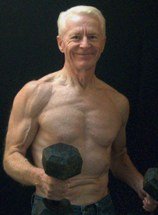| Back to Back Issues Page |
 |
|
The Gray Iron Fitness Newsletter, Issue #173. Avoiding plateaus. February 15, 2016 |
Hi February 15, 2016
February 15, 2016
In this newsletter . . . Avoiding Training PlateausBeginners at weight training usually start with a straight-line progression plan for building strength and fitness. Here’s an example of how that might work: They begin lifting a weight that is manageable without straining for, say, 12 repetitions. At the next training session, they would do 13 reps. Then 14 at the following workout and, finally, 15. Next, they’d add some weight to the bar – not too much – and go back to doing 12 reps, and begin the progression steps over again. It works in a similar way with cardio. Say that you choose walking for cardiovascular exercise. You start off easy and at each subsequent workout, you add some minutes to your total. That is how classic straight-line strength and fitness progression works. It’s a solid beginner's plan — for a while. But eventually you hit a wall. Call it what you want, a “sticking point,” a “plateau,” or whatever. The thing is, if you simply try to push through it while doing the same things in the same way, you’ll inevitably experience physical or psychological burnout. The great Russian weightlifters realized this long ago and came up with an training protocol known as periodization. It works, more or less, like the following:
Following the active rest period, they would begin another cycle. You may not be a power lifter or want to be one; nevertheless, once you have progressed beyond the beginner stage, almost all training, whether it is for a particular sport, bodybuilding, or general conditioning, ought to follow a somewhat similar format of: 1) gradual buildup; 2) peaking; and 3) backing off for a bit (active rest). Why? No one can continually push to the limit at every workout and make progress. While on the subject, it should also be noted that Russian lifters do not train to failure. Total, all-out efforts are reserved for competitions only. Most of us are not in competitions. Still, the principle remains the same. Test your limits once in a while, but trying for a personal best at every workout only leads to dreading your training, to possible injury, and to eventual failure. Train with variety. Mix it up. Change your routine. Do high reps for a while. Then switch to medium reps with heavier weights. You get the idea. Most people make greater progress training this way. And most enjoy their training more. Regular exercise requires self-discipline, but the enjoyment aspect has to be part the lifestyle if it’s to be lasting. For more fitness lifestyle information, please visit my website. If you like the newsletter, we're making it easy to share it . . .  Newsletter Policy The Gray Iron Fitness Newsletter is a free publication sent twice monthly to subscribers. The purpose is to provide honest and realistic fitness information for people age 50 and above. I have never been paid or received compensation of any kind to write a positive review or endorse a product. If I say that I personally use a product or service, it is because I find value in it and have paid for it with my own money. Like newspapers, magazines and television, this newsletter and my web site contain advertising and marketing links. Naturally, I am compensated for these. The newsletter and web site provide information to help users establish and maintain a fitness lifestyle. But fitness information is not the same as fitness advice, which is the application of exercise and dietary practices to an individual's specific circumstances. Therefore, always consult with your physician for assurance that fitness information, and your interpretation of it, is appropriate for you. Your comments and questions are always appreciated. Simply click on the "Reply" bottom. |
| Back to Back Issues Page |